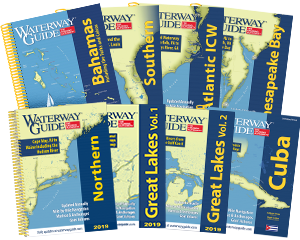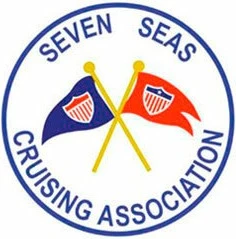If you're wondering why this story's headline "THE ANSWER IS #3." It is the answer to our new news quiz series titled "Deeper Diver News Trivia Quiz." This quiz is drawn from the newsletter each week. If you'd like to participate then click here to subscribe to our newsletter.
Editor's Note: This column is part of a partnership between Waterway Guide Media and the US Coast Guard Auxiliary. Commodore Vincent Pica, First District, Southern Region (D1SR) United States Coast Guard Auxiliary provides our readers with his valuable insights on a regular basis.
As we probably all make New Year’s resolutions to go on a diet, we keep getting reminded that we are getting heavier as we get older. No matter where we turn, someone is telling us that we are getting fat and need to be thinner!
Guess what? So are our boats! Yes, as boats get older, they get heavier and that has a lot to do about being less “sea-kindly” and more “tender” as they get older (and our reflexes get slower – not a particularly good combination.) With fuel always subject to geopolitical roilings, here are some examples of how the boat is getting heavier – and more expensive to drive.
New Stuff
We add things to our boat that weren’t there when we bought it. An ice chest may be added so we don’t have to lug one from the car. We add an additional ice chest so we can bring more ice so we can stay out longer and catch more fish (hopefully!). We pile up the cuddy cabin, a.k.a., the boat’s attic, with safety and fishing equipment so we don’t have to lug them from the car.
And don’t forget that new 4-stroke engine you added – so much quieter, so much more fuel-efficient and so much heavier per “horse of power,” at least 20% heavier would be my guesstimate, that makes a 400lb 200hp 2-stroke weigh in at nearly 500lbs as a 4-stroke state-of-the-art power plant and the same hull sits in front of it.
Boats Get “Wrinkles” too
More insidiously, through tiny cracks in the gel coat, water seeps inside the hull and the boat gets 8 lbs heavier per gallon and it seeps, generally, aft where the boat is naturally heavier per square foot of hull due to the engine, making it harder to see over the bow when you gun the engine and start to “dig the hole” that getting up on plane gets you out of and it is now harder to get on a plane, i.e., you have to go faster, to get up on plane since the boat is heavier in the stern than when it was manufactured, an endless spiral.
Remedies
What to do about it? There are only 2 or 3 things that you can do. First, get rid of anything that isn’t essential. There are 10 weekends in a summer. You aren’t going to boat on every one of those 20 days – unless you are between spouses and looking for one that wants to live on the boat with you!
How much of a big deal is it to cart just the things you need – not everything you own all the time - from the car or the dock locker that you installed at the foot of your slip? Second, you may want to look into trim tabs – small “flaps” that are installed under your transom that will help you get up onto a plane faster. What they save in fuel when “digging out of the hole” will quickly cover their costs.
And don’t underestimate the safety factor that you’ll be able to see over the bow sooner. Third, you may need to change your prop! The engine may be plenty powerful enough to move your mini-warehouse but it can’t turn the propeller any faster due to its pitch (angle that it cuts through the water.) Counter-intuitively, the lower the prop pitch, the better your shot out of the hole.
However, this comes at a price: top speed. The lower pitch makes the engine reach maximum rpm at slower speeds. Conversely, a higher pitch will deliver greater top speeds, but slower acceleration. I recently went from a 3-blade prop to a 4-blade prop – the same trade-off, up on plane sooner and more easily but lost about 10% of the wide-open-throttle (WOT) speed. For me, it was well worth it as I need to get out of the hole 100% of the time I apply thrust but rarely need to operate a WOT.
Talk to your dockmaster about who he or she uses when they re-engineer props for customers. Go see them and talk about your options. This is some art, some science and some superstition. Talk it through with people who make a living engineering propellers. It will make a difference.
If you don’t think about these things, “you gonna need a bigger boat.” (Yes, Virginia, it has been over 40 years.)
BTW, if you are interested in being part of USCG Forces, email me at [email protected] or go direct to the D1SR Human Resources department, who are in charge of new members matters, at DSO-HR and we will help you “get in this thing…”











